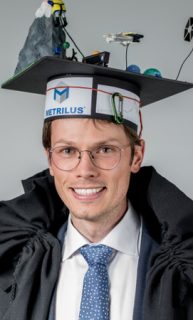Peter Fürsattel
Accurate Measurements with Off-the-Shelf Range Cameras
Abstract
Distance cameras have gained large popularity in the last years. With more than 24 million Microsoft Kinect units sold and the proliferation of 3-D sensors for biometric authentication, these cameras have reached the mass market. Distance cameras capture an image in which each pixel encodes the distance to its corresponding point in the scene. This opens up new application possibilities which are difficult or even impossible to implement with normal gray-level or color cameras. These new applications are particular useful if they can be implemented with low-cost consumer 3-D cameras. However, this is problematic as these sensors have only limited accuracy compared to professional measurement systems and are thus not yet sufficient for many applications. In this thesis, several aspects that affect the accuracy of time-of-flight and structured light cameras are discussed.The calibration of cameras, i. e. the calculation of an exact camera model, is of major importance. The estimation of these models requires point correspondences between the scene and the camera image. Whenever high accuracy is required, it is recommended to use calibration patterns such as checkerboards. This thesis introduces two methods, which find checkerboards more reliably and accurately than existing algorithms. The evaluation of the measurement errors of distance cameras requires reference values that are considerably more accurate than those of the camera. This thesis presents a method that allows using a terrestrial laser scanner to acquire such data. However, before the reference data can be used for error analysis, it is necessary to transform the measurements of both sensors into a common coordinate system. For this purpose, an automatic method was developed that reliably calculates the unknown transformation based on a single calibration scene. The accuracy of this approach is confirmed in several experiments and clearly exceeds the accuracy of the competing state-of-the-art method. In addition, it is possible to generate reference distance images with this method, which can subsequently be used for the evaluation of distance cameras.Time-of-flight (ToF) cameras have some error sources that are characteristic for this measurement principle. In order to be able to better compensate for these errors, it is first necessary to investigate the nature of these errors. This thesis also presents a comprehensive, standardized evaluation of the systematic errors of ToF cameras. For this purpose, six experiments are defined, which are subsequently carried out with eight ToF cameras. The evaluation of these experiments shows that the characteristic errors are differently pronounced with the investigated cameras, but nonetheless, can be observed even with the most recent models. Finally, a new calibration method for structured-light sensors is proposed, as well as an algorithm which refines parametric models of objects. The calibration method allows calculating a complete sensor model based on two or more images, even if the projected pattern is unknown. This is particularly necessary if the sensor does not use a regular projector, but emits the pattern with a diffractive optical element. This part of the thesis also presents a novel refinement method for parametric models that uses the developed camera model. The evaluation results show that the proposed method computes more accurate model parameters than state-of-the-art fitting algorithms.
